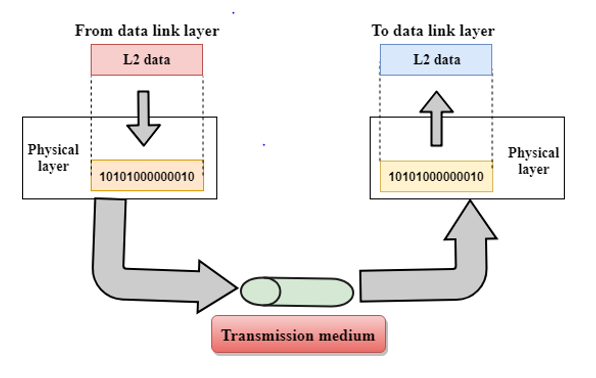Home »
Computer Network
Physical Layer: What It Is, Design Issues, Functions
Description and Functions of Physical Layer in the OSI model: In this tutorial, we are going to learn what the physical layer is and the Functions of Physical Layer in the OSI model in Computer Networking? we will also discuss the Design issues with Physical Layer and the working of Physical Layer with the help of its diagram.
By Monika Jha Last updated : May 05, 2023
What is Physical Layer?
The physical layer consists of all the functions required to transmit a bitstream over a Physical medium. The electrical and mechanical specifications of the interface and transmission medium deals by this layer.
- This is the lowest layer of the OSI reference model.
- For transmission, it defines all the procedures and functions that physical devices and interfaces have to perform.
- It is physical and tangible as well.
- However, it does not deal with the actual physical medium (like fiber, copper).
- Physical Layer devices are Hub, Repeater, Modem, Cables.
This figure shows the position of the physical layer concerning the transmission medium and the data link layer.

Physical Layer
Design Issues with Physical Layer
- The Physical Layer is transmitted raw bits over a communication channel.
- Making sure that when one side sends a 1 bit, it is received by the other side as a 1 bit and not as a 0 bit.
- The design issues here mostly deal with electrical, mechanical and timing interfaces.
Functions of Physical Layer
The following are the functions of physical layer in the OSI Model:
1. Physical characteristics of interfaces and media
It defines the characteristics of the interface between the devices and the transmission medium. It also defines the type of transmission medium.
The capacity of transmission media is bandwidth. It defines transmission speed and communication methodology.
2. Representation of bits
The physical layer data involves a stream of bits (sequence of 0's and 1's) without any interpretation. To be transmitted bits must be encoded into the signals - electrical or optical.
- The physical layer defines the type of encoding (how 0's and 1's are changed in signals).
- This layer is responsible for the bit by bit delivery of the data to its upper layer called the MAC layer. Physical layer obtains data in the form of signals or the radio signals or the optical signals.
- The physical layer is responsible for delivering those signals from a cable, a Wi-Fi router or an optical fiber.
3. Data Rate (Transmission Rate)
The number of bits sends each second is also defined by the physical layer. In other words, the physical layer defines the duration of a bit also.
4. Synchronization of bits
It is necessary to have synchronization between sender and receiver at the bit level that is the clocks of the sender and the receiver must be synchronized.
5. Line configuration
The physical layer is responsible for the connection of devices to the medium. Two devices are connected through a dedicated link in a point-to-point configuration.
- A single link is shared among several devices in a multipoint configuration,
- The computer generates data in the form of '0's and '1's. So, there are different varieties of cable that carry data from our computer to the switch or a nearby port.
- In this case, an encoder is responsible for the encoding of data before sending them on the different wires just like traffic police.
- Then, the decoder will similarly extract those data from the different wires and make them readable to the computers.
6. Physical topology
The Physical topology determines how devices are connected to create a network. Devices can be using a mesh topology (every device can be connected to other devices), a star topology (all the devices are connected through a central device), a ring topology (devices are connected to the next forming a ring), or a bus topology (every device shared a common link). For digital and analog communication, data signaling encompasses timing and coding rules.
7. Transmission mode
The mechanism of transferring data or information between two linked devices connected over a network, is referred to as Transmission Modes.
They are simplex, half-duplex, or full-duplex.
- In the simplex mode, communication is unidirectional that is data can be sent only in one direction. This means you cannot send a message back to the sender just like a one-way street.
- In the half-duplex mode, each station can transmit and receive the data as well.
- In a full-duplex (or simply duplex) mode, the communication is bi-directional, i.e., the data flow in both the directions at the same time.
Advertisement
Advertisement